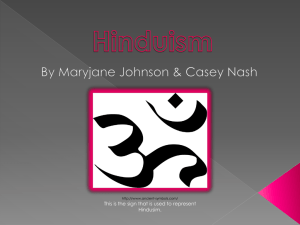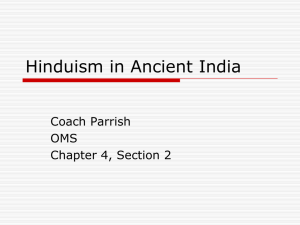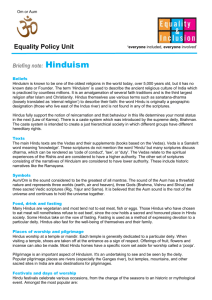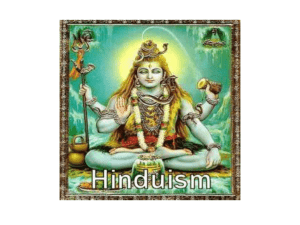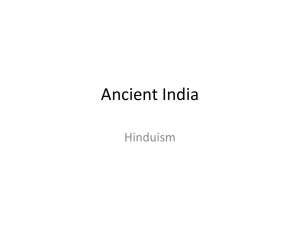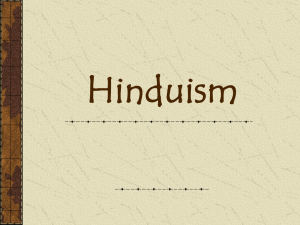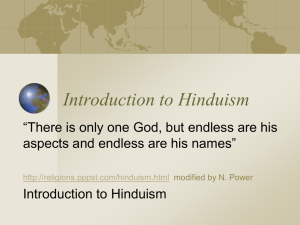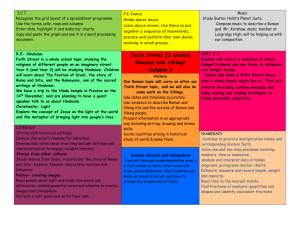Hinduism - SMS Tiger Team
advertisement
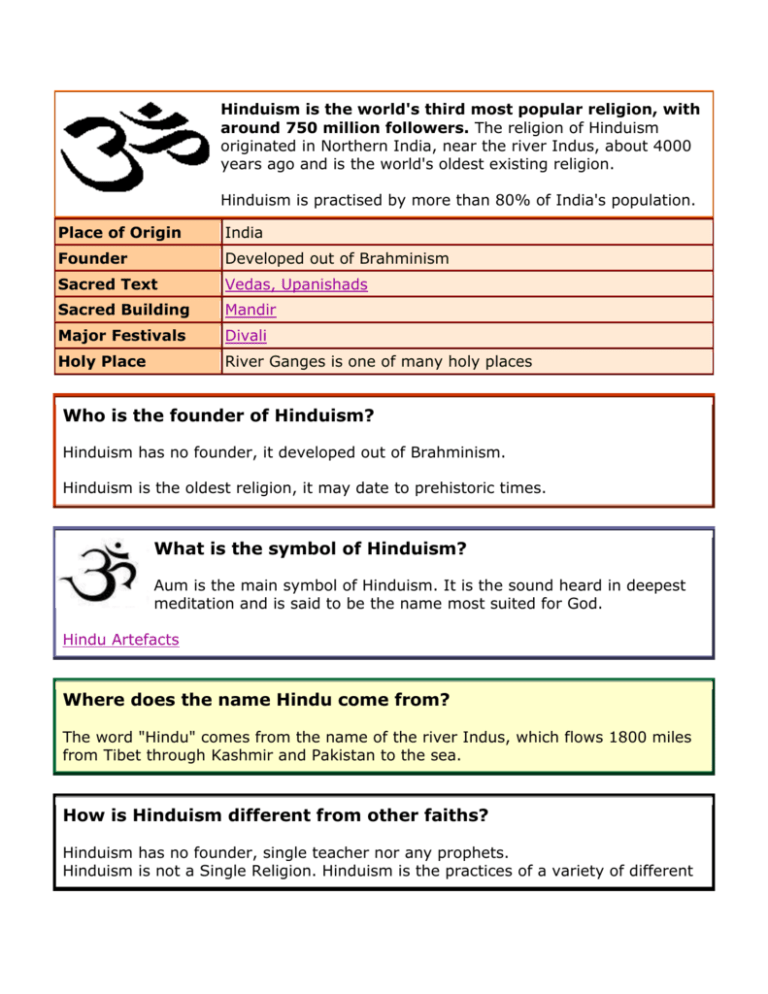
Hinduism is the world's third most popular religion, with around 750 million followers. The religion of Hinduism originated in Northern India, near the river Indus, about 4000 years ago and is the world's oldest existing religion. Hinduism is practised by more than 80% of India's population. Place of Origin India Founder Developed out of Brahminism Sacred Text Vedas, Upanishads Sacred Building Mandir Major Festivals Divali Holy Place River Ganges is one of many holy places Who is the founder of Hinduism? Hinduism has no founder, it developed out of Brahminism. Hinduism is the oldest religion, it may date to prehistoric times. What is the symbol of Hinduism? Aum is the main symbol of Hinduism. It is the sound heard in deepest meditation and is said to be the name most suited for God. Hindu Artefacts Where does the name Hindu come from? The word "Hindu" comes from the name of the river Indus, which flows 1800 miles from Tibet through Kashmir and Pakistan to the sea. How is Hinduism different from other faiths? Hinduism has no founder, single teacher nor any prophets. Hinduism is not a Single Religion. Hinduism is the practices of a variety of different religious groups which come out of India. What do Hindus believe? For many Hindus, religion is a matter of practice rather than of beliefs. It's more what you do, than what you believe. Hindus believe in a universal soul or God called Brahman. Brahman takes on many forms that some Hindus worship as gods or goddesses in their own right. Hindus believe that there is a part of Brahman in everyone and this is called the Atman. Hindus believe in reincarnation - a belief that the soul is eternal and lives many lifetimes, in one body after another. The soul is sometimes born in a human body, sometimes in an animal body and sometimes in a plant body etc.. Hindus believe that all forms of life contain a soul, and all souls have the chance to experience life in different forms. Samsara means going through the cycle of repeated births and deaths (reincarnation). Hindus believe that existence of this cycle is governed by Karma. What is Karma? Hindus believe that the soul passes through a cycle of successive lives and its next incarnation is always dependent on how the previous life was lived. (Similar to Buddhist beliefs) Karma is the cause of our particular destiny. Misfortunes in our present life are the result of acts that we have committed in the past. In the same way, our actions in our present lives will determine our fate in the lives that follow. Hindus therefore aim to live in a way that will cause each of their lives to be better than the life before. What is Moksha? The spiritual goal of a Hindu is to become one with Brahma. This freedom is referred to as moksha. Until moksha is achieved, a Hindu believes that he/she will be repeatedly reincarnated in order that he/she may work towards self-realization of the truth (the truth being that only Brahman exists, nothing else). What is the Hindu way of life? For many Hindus there are four goals in human life (purusharthas); 1 Moksha - the release of the soul (Atman) from the cycle of rebirth. The individual soul (Atman) unites with Brahman the universal soul. There are different ways to Moksha. spiritual - involves acquiring spiritual knowledge through yoga and meditation. devotion to god working selflessly for the good of society. How a person is reincarnated is determined by karma. 2 Dharma - the code for leading one's life. Respect for elders is considered important and many consider marriage as a son's religious duty. 3 Artha - the pursuit of material gain by lawful means. 4 Karma- through pure acts, knowledge and devotion, you can reincarnate to a higher level. The opposite achieves the contrary result. How do Hindus achieve Moksha? There are four different paths to achieve Moksha which a Hindu can take. The Hindu can choose one or all four of the paths they are: 1 The path of knowledge - Jnana-Yoga Spiritual knowledge -leading to the knowledge of the relationship between the soul (atman) and God (Brahman) 2 The path of meditation - Dhyana-yoga The idea is to concentrate so you can reach the real self within you and become one with Brahman 3 The Path of Devotion - Bhakti-yoga Choosing a particular god or goddess and worshipping them throughout your life in actions, words and deeds. 4 The path of good works - Karma-yoga This involves doing all your duties correctly throughout your life. Why are there so many Hindu Gods? Hindus actually only believe in one God, Brahman, the eternal origin who is the cause and foundation of all existence. The gods of the Hindu faith represent different forms of Brahman. These gods are sent to help people find the universal God (Brahman). Most Hindus have a personal god or godess such as Shiva, Krishna or Lakshmi to whom they pray regularly. The three most important Hindu gods (forms of Brahman) are: Brahma - known as the Creator. (Description) Vishnu - Known as the Preserver (Description) Shiva (Siva)- known as the Destroyer. (Description) Other Hindu gods include: Saraswathi - Goddess of Wisdom - Wife of Lord Brahma. (Description) Saraswathi is the Hindu goddess of knowledge, music and all the creative arts. Lakshmi - Goddess of Wealth - Wife of Lord Vishnu. (Description) Lakshmi is the goddess of light, beauty, good fortune and wealth. Parvati - regarded as a representation of Shakti. Parvati is the wife of Lord Shiva and the Godess of household and motherhood. (Shakti is by literal definition sacred force, power, or energy. Shakti is the personnification of Brahman as feminine) Ganesha - Son of Shiva and Parvati. (Description) The Hindu god in a human form but with the head of an elephant.(pictured right) Pictures and descriptions of Hindu Gods Images of Hindu Gods (updated link) What is the Hindu place of Worship? Most Hindus worship (puja) every day at home and have a shrine there. A shrine can be anything from a room, a small altar or simply pictures or statues. Family members often worship together. At the shrine, Hindus make offerings to a murti. A murti is a sacred stautue of God, or a god or goddess. The Hindu building for communal worship is called Mandir (Hindu Temple). The temples are dedicated to different gods and are the focus of religious life. Outside India, people mainly gather at the mandir at the weekend. Worshippers repeat the names of their favourite gods, goddesses, and the mantras. Water, fruit, flowers and incense are offered to the gods. What is Hinduism's Holy book? The most ancient sacred texts of the Hindu religion are written in Sanskrit and called the Vedas. Hinduism does not just have one sacred book but several scriptures. The Vedas scriptures guide Hindus in their daily life. They also help to preserve the religious dimensions of family and society. Hindus have developed their system of worship and beliefs from the scriptures. There are two main categories of the Hindu scriptures: Shruti ("that which is heard") consists of the four Vedas and Upanishads scriptures. Smriti ("that which is remembered") composed of traditional texts, including the Dharma Shastras (legal and ethical texts), the Puranas, and the folk/historical legends known as the Mahabharata and Ramayana. The Hindu Holy Scriptures are mainly comprised of the following works written in the Sanskrit language: 1. The Vedas Rg-Veda (Rigveda), Yajur-Veda, Sama-Veda, Atharva-Veda (see further down ) 2. The Upanisads - These consider the nature of the individual soul (Atman) and the universal soul (Brahman.) One of the Upanishads contains the earliest reference to the reincarnation of the soul in different bodies (transmigration) of the soul. 3. The Smrutis - (‘tradition) are the Laws of Manu (250 BC) 4. Ramayana - Contains the story of Rama and his devoted wife Sita. She is kidnapped by the demon king Ravana but is later freed by Rama with the help of the monkey god Hanuman. The poem is about how good will always triumph over evil and Rama and Sita are held up as role models for the perfect husband and wife. 5. Mahabharata - An epic poem telling the story of a war between two branches of a family. The Bhagavad-Gita forms part of this and means "The Song of God." 6. The Puranas - A collection of ancient tales about the different incarnations and the lives of saints. What are the Vedas? The Vedas are the oldest religious texts in Hinduism. The word Veda means knowledge. It is believed that the Vedas were orally revealed by Brahma to certain sages, who heard them and passed them down in an oral tradition. They were not written down; in fact this was prohibited. Because of this earliest oral tradition continuing even now when the Vedas are available in the written form, the Vedas are still known to be Sruti or shruti - ' that which is heard '. The Vedas are mainly comprised of of hymns or mantras written in the Sanskrit language. They cover various subjects, from nature to everyday life and behaviour, and form the basis of all other religious writings. The books are so special that they are often kept in glass cases. The four Vedas are: Rg-Veda (Rigveda) - The oldest and holiest Veda. Yajur-Veda Sama-Veda Atharva-Veda Each Veda is divided into four sections: The Samhitas - The oldest portion - Contains the mantras and hymns The Brahmanas - The ritualistic teachings - They are written in prose and explain the hymns. The Aranyakas - The meditational section The Upanishads - The mystic and philosophical. They consider the nature of the individual soul (Atman) and the universal soul (Brahman.) One of the Upanishads contains the earliest reference to the reincarnation of the soul in different bodies (transmigration) of the soul. The Vedas are the law. Most beliefs, concepts, and ceremonies are based on information contained in the Vedas. What are the practices of Hindus? The practice of Hinduism consists of rites and ceremonies centering on birth, marriage, and death. There are three basic practices: 1 Worship (called Puja) This is an integral part of the faith. Offerings (puja) are usually made to representations of the gods. 2 Cremation The dead are burnt not buried 3 Compliance with the rules of the caste system The caste system, prescribed in the vedas, was 'a division of society to preserve society' similar to the society in ancient Egyptian times. Each group had rules of conduct to be obeyed. The caste system divided people by occupation i.e. teachers and philosophers were brahmins; fighters were kshatriya; shopkeepers, moneylenders and tradespeople were vaishya; and servants and cleaners were shudra. No caste was higher or more important (superior) to another. All were equal and aknowledged as essential to the society. With thanks to Nirmisha Bhatt and Smruti Desai for providing us with information about the caste system Is pilgrimage an important aspect of Hindusim? Yes, pilgrimage is important to Hindus. What are the popular pilgrimage places? Popular pilgrimage places are rivers, temples, mountains, and other sacred sites in India. As these are sites where the gods may have appeared or become manifest in the world.
